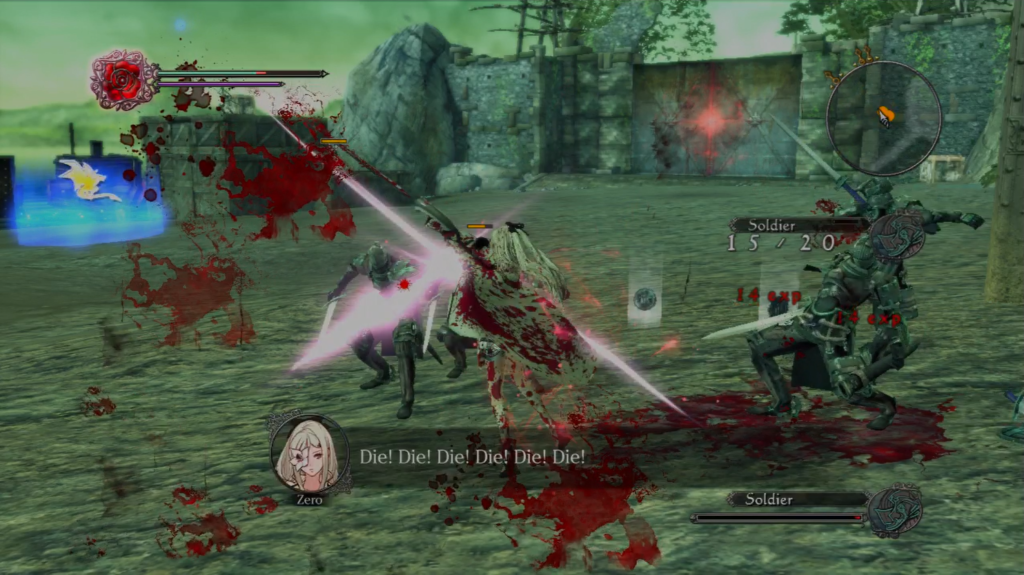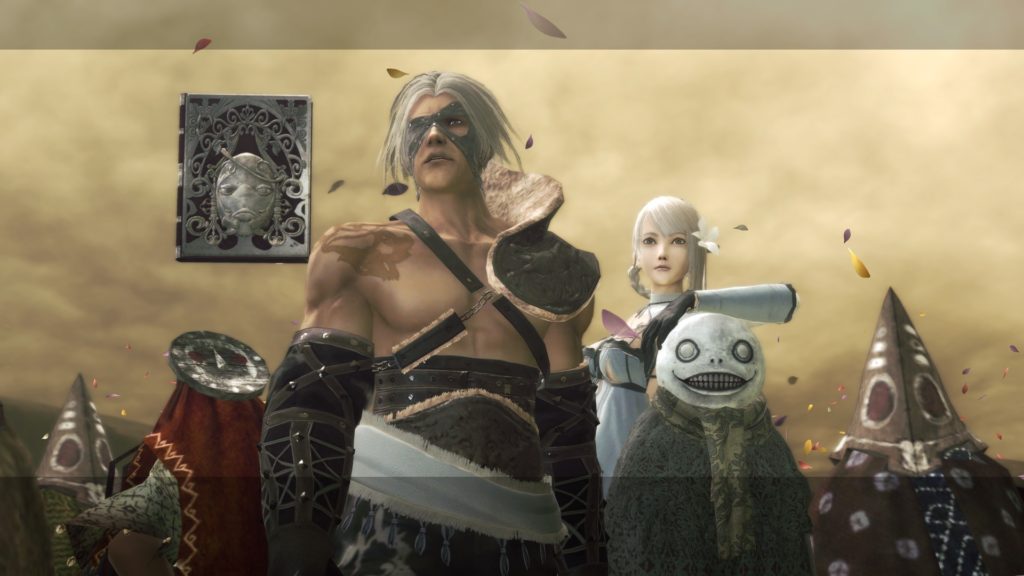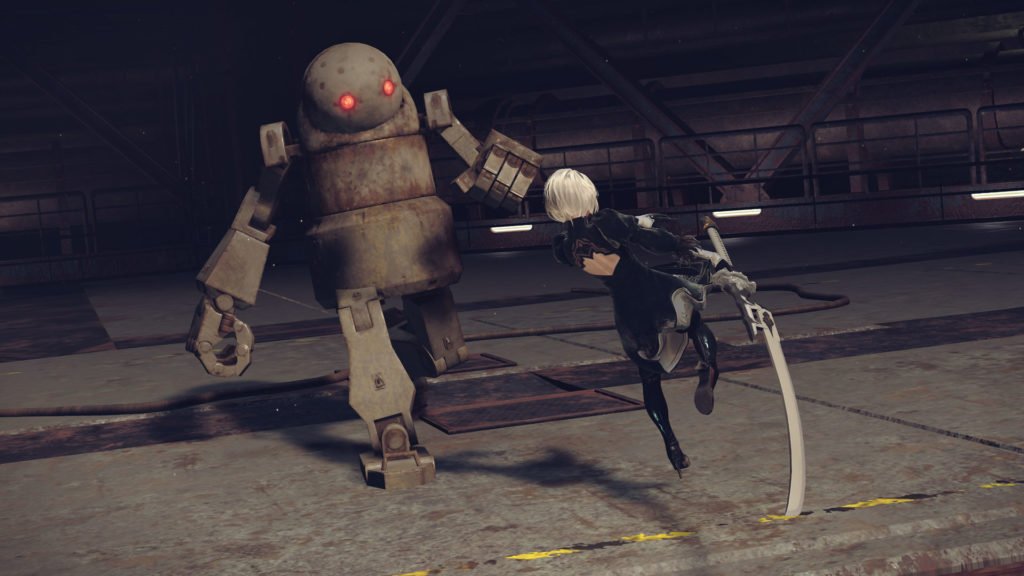It’s hard to explain why NieR: Automata is something special without getting into its context, because from any logical standpoint, this game shouldn’t exist. It does exist mainly because of 9/11 and a man named Yoko Taro.
Yoko Taro, creator of the Drakengard and NieR games, is an oddity even in Japanese game development. For example, to show support for Atlus’ upcoming game Project Re Fantasy, Yoko Taro donned a mask of one of his most iconic (and disconcerting) characters, referred to himself as the creator of “NieR and Draken-something”, and proceeded to explain that whatever amazing work Atlus does, NieR: Automata will be screwed by it because of market overlap. He immediately follows this by plugging NieR: Automata’s release date.
It’s simultaneously blunt and bewildering, hilarious and pitch-black. It involves a mask and/or a puppet. It’s Yoko Taro.

Drakengard 3
Like most fantasy RPGs, his Drakengard games have a lot of killing. But, unlike many games, this reflects in the insanity of its protagonists; they aren’t exactly heroes. On the surface, for instance, one sidekick in Drakengard 3 is a violent male teen who constantly tries to have sex with the female protagonist. Pretty par for the stereotype course, until you find out that he was raised his whole life as the slave to a dominatrix. But the character never acknowledges the trauma, or wallows in the horror of that fact. It’s just stated and left for the player to understand. Yoko Taro expects the player to connect the dots that, oh yeah, these characters are humans, and acting like stereotypes is a coping mechanisms.
In the midst of developing this series and ruminating on killing, 9/11 happened. Yoko Taro struggled to make sense of it, but came to an unexpected and new conclusion. “The vibe I was getting from society was: you don’t have to be insane to kill someone,” Yoko Taro explained in an interview with Game Church. “You just have to think you’re right.” This led to NieR, a game that truly questions society’s expectations of its heroes.
It shows in NieR’s sidekicks: A beautiful, lingerie-clad young woman, and what looks like the unholy combination of a mage, skeleton, and marionette. The creepy puppet-kid, however, is the sweetest character in the game, and the woman is foul-mouthed, antisocial, and hyperviolent. And the explanations for why they look, and act, the way they do are unexpectedly powerful and affecting. This “rage against the dying of the light” dark fantasy is technically a sequel to Drakengard’s absolutely absurd “Ending E”, where the protagonist and his dragon are warped into modern-day Tokyo and shot down by jets. It’s insane. And yet, finding how exactly that ties to NieR is an incredible revelation that also sets up one of the hardest gut-punch moments in gaming.
In other words, NieR is something unexpected –and special.

NieR
Considering its absurd origin and that its story takes multiple playthroughs to fully grasp, not to mention the sometimes rough gameplay and repetitive missions, and you’ve got a recipe for the cult-hit NieR became. No one really expected a sequel (it didn’t exactly break sales records) and the game’s final ending wraps in such a way that you don’t need one.
Which brings us to Platinum Games. The character-action of NieR had promise, and Platinum, the studio behind every truly great character-action game that isn’t Devil May Cry (Bayonetta, Wonderful 101, Metal Gear Rising: Revengeance) saw that promise. Platinum also does “escalation” better than any other studio, at least in terms of stakes and scale of gameplay, but their stories have often been pretty run-of-the-mill for how insane the action is.
NieR: Automata, however, takes the incredible world-building of Yoko Taro (who is directing and scenario-writing the project) and gives it the ambitious gameplay and genre-swapping the game deserves. Simply locking cameras to side or top-down views makes the feeling of the game change, much like the shifting player perspective NieR is known for.
And we know it works because of the demo.

NieR: Automata
NieR: Automata has a demo out now, and its action is on-par with Platinum’s best games, while still being accessible. There is no combo-list included in the game (which is unusual for Platinum) because it focuses more on switching up your approach than pulling off an insane combo. Knowing when to dodge, shoot, or strike is more important than doing so with maximum efficiency.
The story beats of the demo may not seem earth-shattering to series newcomers (though its ending certainly comes as a surprise), but NieR vets will find fascinating hints of the first game in this sequel, which is set 9,929 years in the future. From what we know of the game so far, it looks like newcomers to NieR will be able to have an experience similar to those that played the original, and yet enough mystery remains in the sequel that old hats will desperately want to know how we got from NieR to here. If that reveal is anything like the reveal of how we got from Drakengard’s Ending E to NieR, this game is going to blow minds.
And more importantly, as Drakengard and NieR fans know, that violence serves a story purpose. Quirky yet dark, the unique tale of NieR deserved polished gameplay, and with Platinum and a bigger budget, NieR: Automata could be the best story game of 2017.

